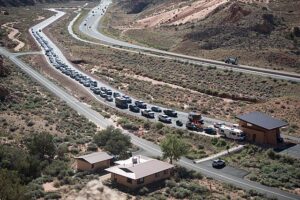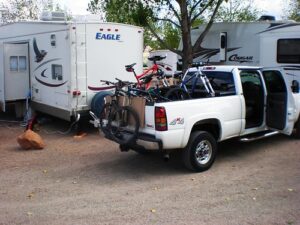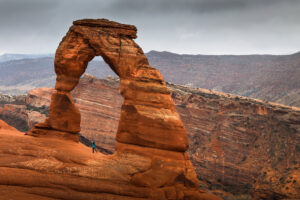It’s a sunny summer day, and you’re looking forward to some local shopping in your sleepy Southwestern town. You soon realize, though, that it’s easier said than done—traffic is backed up to the outskirts, and the general store’s been replaced with a hotel bar. You’re outnumbered 500 to 1 by out-of-towners.

This is summer in Moab, Utah.
In a given season, the Utah town of 5,000 bordering Arches National Park will see 2.5 million visitors. Outdoor recreators arrive in hoards to enjoy the dramatic scenery of the Southwest and the iconic charm of Moab.
Unfortunately, their growing presence threatens the livelihoods of many long-time locals.
Old Moab and the “Uranium Capital of the World”
Moab was not always the resort town we see today.
In the late 19th century, it was a control point on the Old Spanish Trail. When Latter-day Saints settlers took interest in the Grand Valley region, violent conflict erupted between these colonizers and the Navajo and Ute tribes, leading to the founding of Moab in 1902.
In 1912, vanadium and uranium were discovered in the surrounding area, and with the beginning of the Cold War in the 1950s, the industry exploded—for a couple decades. By the 1980s, the uranium industry had all but dried up, and Moab struggled with a 15% unemployment rate and a 23% drop in population.
By the mid-1980s, though, word had gotten out about the natural beauties of Arches National Park, and Moab, in need of an industry foothold, began to rely on tourism as a major income source.
The Changing Role of Tourism
Initially, residents welcomed—or at least required—the large visitor base. “It’s all we have—we need it here,” said long-time resident and Navtec Expeditions owner John Williams in a 2017 interview. Longer, busier seasons, however, have threatened affordable housing and infrastructure in Moab, as well as the integrity of the Park itself. Visitors “just don’t know what the dos and don’ts are—they wouldn’t do it if they knew better.”
To make matters worse, the quantity of tourists and length of their visiting season have only increased over time. Williams noted, “The last two years have been the biggest in the travel industry in Moab that I’ve ever seen. Seasons are extending—we even ran trips clear through November last year.”
New Construction and Housing Displacement

The problem most cited by Moab residents is the impact on housing and affordability. Large-scale developments like luxury hotels, resorts, and chain restaurants have moved into Moab to capitalize on the tourist consumer base.
High-end lodging such as the new HooDoo Hotel by Hilton are in sharp contrast to the shrinking affordable housing market, and they raise surrounding property values and contribute to wealth inequality in Moab.
Rising property values can have problematic side effects effects such as:
- Skyrocketing rent
- Increased property taxes, affecting fixed income homeowners
- Limited construction of new affordable housing
- Limits on who is able to purchase property
As renting has become less affordable, some residents have even been pushed into cars, tents, and mobile homes.
Citizen Push-Back
In the face of such extreme pressure, many residents feel that change is unlikely unless the Moab City Council decides to make some serious changes to zoning and infrastructure. The city has held budget hearings to discuss a proposal to allocate funds from high property taxes to improving overloaded infrastructure.
In the meantime, local organizations have developed their own community support resources. Community Rebuilds is a Moab nonprofit working to sustainable affordable housing.
Wabi Sabi is a thrift store and community center that helps to fund local nonprofits and community projects. The Moab Valley Multicultural Center seeks to provide resources to create a healthy, vibrant community.
Moab Fights On—But What’s Our Responsibility?

Moab locals do not seek to bar enthusiastic travelers from the wonders of the Red Desert.
Instead, it is up to us as recreators to take responsibility:
- In Moab, and in other tourism-dependent destinations, we can keep money in the hands of local community members by lodging and shopping at locally owned businesses.
- By limiting our travel to off seasons, we can help reduce pressure on infrastructure and keep income flowing throughout the year.
- In all cases, we should treat locals respectfully.
Our desire to experience Southwestern wonders such as Arches National Park is born of a love for the landscape, the earth, and its people. As visitors, we seek to understand and appreciate all that these places have to offer. By being mindful in our travel, we can prevent and lessen these cases of rural gentrification and displacement.
